“What if the research and development department created to produce the first atomic bomb was a front for a series of other, more unusual, programs?” Such is the apparent premise of a current comic book series from Image Comics, titled The Manhattan Projects (note the plural), written by Jonathan Hickman and pencilled by Nick Pitarra.
I say, “apparent” because, after having read the first four issues (at least three more are forthcoming), I’m not really sure that’s the best way to sum up what it’s about. It’s really more like, “What if the cast of characters from World War II research and development projects were transposed into a somewhat standard comic book science fiction setting?” Which isn’t quite the same thing.
The plot, so far as I’ve understood it so far (it is not completely linear, which is not in itself a criticism), has something to do with opening up portals between parallel universes, or something along those lines. There are also aliens. And lots and lots of robots.
Which isn’t awful, but I had expected it to be more firmly set during World War II, based on the initial description (and name), but it’s really not. What makes it feel silly is that the bomb, the V-2, and other actual World War II technologies look quite mundane and uninteresting next to cyborg implants, robot androids, all-knowing supercomputers, and, you know, dimensional warp gates. Who cares about “Little Boy” next to all of those?
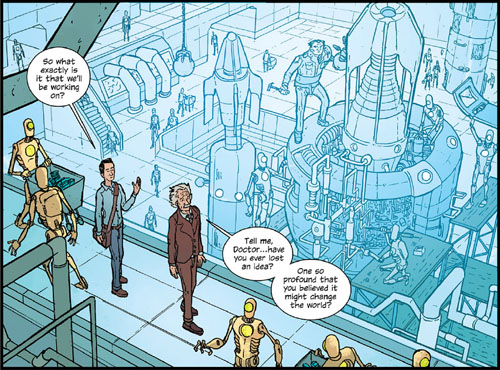
Cyborg Wernher von Braun builds a rocket while Richard Feynman and Albert Einstein look on. Surely building an army of robot helpers is a lot harder than building a simple rocket? This is kind of what I’m talking about.
But if you put that all aside, and regard it instead as a comic book that happens to star otherworldly versions of Manhattan Project characters you know and love, it’s actually kind of fun. The characters often quite inspired and made this atomic historian laugh. It’s clear that Hickman did some research and took the time get really grok some of these figures.
(I should say, explicitly, that there are actually a number of graphic novels/comic books devoted to actual Manhattan Project history. The work of Jim Ottaviani stands out here. I’ll talk about those another time — this post is just about this particularly pulpy contribution.)
J. Robert Oppenheimer has been made literally fractured — his real-life weirdness, inconsistency, and occasional callousness is translated, by the logic of the comic book, into a sociopathic character with multiple personalities. It’s not a flattering depiction — he’s more psychopath than genius — but it’s more interesting than the usual “hero” and “martyr” takes on Oppenheimer. This fractured aspect of his personality is something I’ve commented on before, so I approve of this literary flourish.
Enrico Fermi is a literal alien of some sort (it isn’t yet explained) — a fitting way to explain the enemy alien‘s otherworldly genius, and one which makes the Fermi paradox all the more amusing. Harry Daghlian, the physicist who died after a criticality accident in late August 1945, lives on in the comics as an irradiated skeleton inside of a containment suit. A little poor taste.
General Groves is more boorish, more violent, more unpleasant than ever. I can’t say I’m too thrilled with the characterization — he comes off as a generic Nick Fury, G.I. Joe sort of character. The real Groves was plenty imperial, but he also felt acutely where his power was potentially threatened (by Congress in the postwar, and he knew that the buck stopped with the President). The Groves of the comic is more or less invincible, and that’s unattractive. He’s also seriously in shape, something which, well, the General Groves of our universe was not.
Most perversely, Richard Feynman is… just Richard Feynman. In this universe, he seems (so far) totally normal. Which makes him one of the only characters played straight in the whole series. Funny, no? Feynman as the only straight man, rather than the crazy guy with the bongos.
The art is quite beautiful (as you can see), extremely well-executed, and lushly colored. Pitarra has a real talent for capturing emotions on human faces, and his characters by and large are completely recognizable when compared to their historical analogues (which is no easy thing to pull off, from looking at other drawings of historical figures).
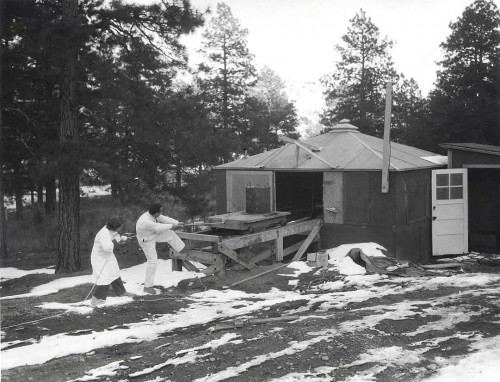
This is what actual 1940s secret science looks like. Compare with the images above. (Via Los Alamos).
Hickman’s plot has yet to really grip me, with the exception of the characterizations. I think the writer has really done interesting things with the characters of the (real world) Manhattan Project — he’s got an eye for both detail and the big picture, and that’s a tough thing to pull off. I was somewhat surprised to read in an interview that he considers the time period of the 1940s to be a compelling aspect of the story he’s telling — the whole thing feels only tenuously set in a World War II period, and most of the scenes (see above, again) have the look of a generic comic book “laboratory” to them (e.g. the Baxter Building), which look nothing like real world scientific laboratories of the time.
Still, I haven’t quite seen anything like The Manhattan Projects — it’s a fictionalization of the Manhattan Project on a level I’d never contemplated, and is something fresh on account of that. And I’m eager to see what Hickman does with Edward Teller. You couldn’t not have Teller in this sort of universe, could you? Could you?
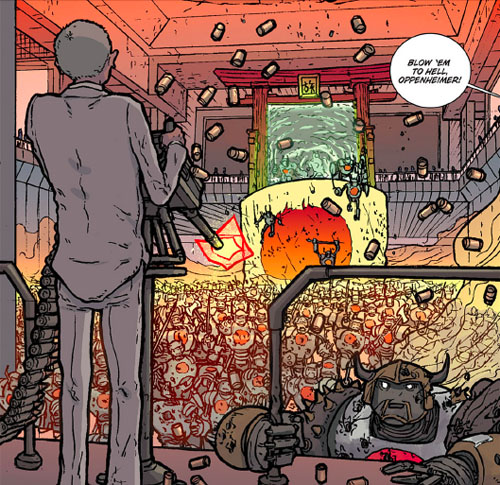
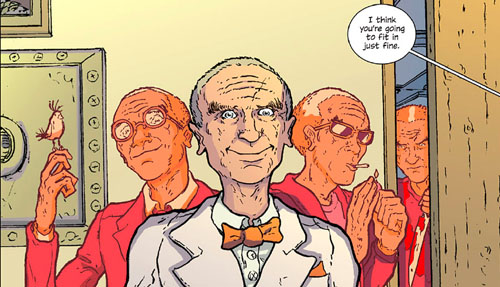

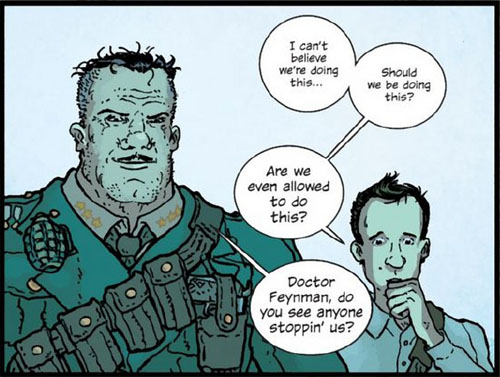


That one “Oppenheimer” lighting a cigarette looks like Hunter S. Thompson.
Teller? They can’t do without him, surely?
My guess is that he’ll be played straight, just like Feynman, but for another reason. Teller was creepy enough about some things there’s little need to embellish.
Or maybe with one small twist. Teller could make an interesting mash-up as a two-headed being if paired with Herman Kahn. That sort of creature could keep itself occupied talking shop all day…
Isn’t the character of Dr Strangelove rumoured to have been based on a Teller/Kahn combination?
Dr. Strangelove = Teller’s big bombs + Kahn’s callous statistical approach to human life + Von Braun’s personal background
I wonder if the whole idea came from the comment from Leó Szilárd (Is he in it? Do they bump him off for giving the game away?) that Hungary was really a front for aliens from Mars and all those migrant Hungarians (Theodore von Kármán, John von Neumann, Eugene Wigner, Edward Teller and Paul Erdős) were really Martians.
http://en.wikipedia.org/wiki/The_Martians_(group)
The cigarette-lighting Oppie reminds me of Spider Jerusalem in Transmetropolitan Warren Ellis & Darick Robertson. It’s a sort of cyberpunk trope (but following on from Hunter S. Thompson).
http://www.cyberpunkreview.com/images_graphicnovel/transmetropolitan04a.jpg
So far I haven’t seen any Hungarians at all, which is odd. But we’ll see… it would be wonderful if the whole group of them were extraterrestrials.
Thanks for taking the time to do this write up, Manhattan Projects is a blast to work on. Very cool blog, interesting and informative.
Thank you, Nick! I’m thrilled that you read my write-up. Keep up the good work; your characterizations of the figures are wonderful. Though I do question your giving Korolev a beard at the beginning of MP4… but that’s my only art objection, historically speaking. Unless it is meant to be a different Korolev…